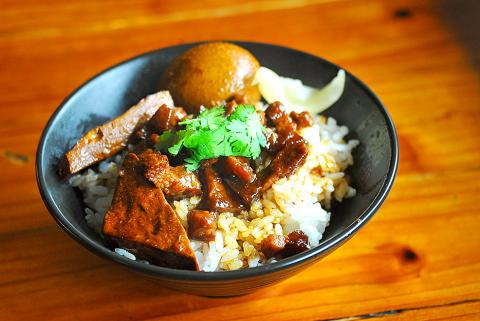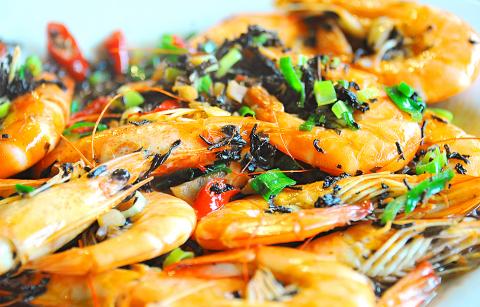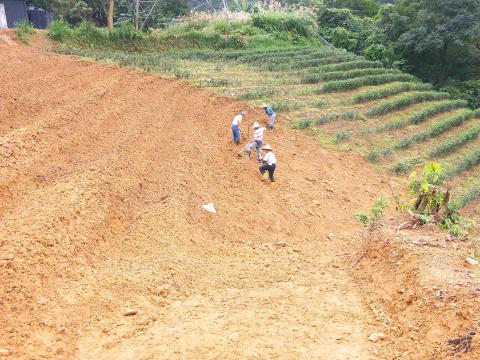Tsai Hsu-chih (蔡旭志) wanted to escape his family’s tea farm so badly that he chose to attend a maritime vocational high school in Keelung.
“I ran from the mountains to the ocean,” the fourth-generation tea farmer and restaurant owner laughs. “That’s far enough, isn’t it?”
Tsai only returned home to New Taipei City’s Sijhih District (汐止) after the local tea industry declined and his family, like many other agricultural operations near Taipei, converted their property into a tea restaurant in the 1990s. Over the decades, Tsai and his wife have maintained a stable living with their tantalizing menu of tea-infused cuisine — but about five years ago, he set out to revive the family’s tea farm, this time using organic methods.

Photo: Han Cheung, Taipei Times
“I guess I got to the age where I started thinking about preserving our heritage,” Tsai says. “Baozhong Tea (包種茶) actually originated near this area … I don’t want people to forget that Sijhih once produced tea. All these mountains used to be tea farms.”
There are no tea-pickers in the area, and Tsai has to drive elderly ladies — the youngest one being 78 years old — from nearby Pinglin (坪林) to perform the task. He feels that if he doesn’t create more interest in the local tea industry now, all will be lost to history soon.
REVIVING SIJHIH’S TEA

Photo: Han Cheung, Taipei Times
I didn’t plan on visiting Tsai’s Natural Tea Manor (天然茶莊) to learn about tea. In fact, my family has lived in Sijhih for 30 years and I had no clue it was once a bustling tea center. But it makes sense — Taiwan’s famous Baozhong Tea originated in adjacent Nangang District (南港), and Tsai’s plantation is much closer to Nangang than downtown Sijhih.
When the coal industry boomed in the mountains of northern Taiwan, Tsai says many local tea farmers turned to mining. As Taipei expanded east, the land here also became valuable, and tea farmers found it more lucrative to “plant houses,” in Tsai’s words. Like Tsai, young people weren’t keen to continue the family business, and soon Pinglin took over as the main Baozhong tea producing center.
I actually came to speak to Tsai about Natural Tea Manor’s participation in New Taipei City’s “cherishing food” (惜食) program that encourages restaurants to make use of surplus or unsellable agricultural products to reduce food waste.

Photo: Han Cheung, Taipei Times
The restaurant maintains a network where they buy “ugly” and excess vegetables from farmers, but that was pretty much it to the story. Tsai’s dreams of reviving Sijhih’s tea industry and his restaurant’s tea menu were much more intriguing.
The main problem Tsai faces, like in many traditional industries, is the lack of skilled workers. The tea pickers and terrace workers have specific experience and knowledge that machines cannot replace, such as discerning which individual plants to pick at which times. While machines can still do the job, it isn’t ideal.
Tsai is betting on reviving the industry first — if he generates enough work in the area, he could start training new people to pick leaves as a part-time job. Young people likely won’t be interested, but he could target housewives or older people looking to re-enter the workforce.

Photo: Han Cheung, Taipei Times
Last week, he hired workers to terrace another piece of land to expand his farm, and he is in the process of setting up a licensed tea processing factory that can support several farms. He wants to attract students and tourists to learn about this area’s history and try their hand at picking and processing tea, and hopes that his success will influence his neighbors to also revive their plantations.
TEA IN EVERYTHING
The Tsai family had no idea how to run a restaurant in the beginning, pretty much catering to the whims of his visitors. They eventually shut the restaurant down to develop their own style using tea leaves.

Photo courtesy of Tsai Hsu-chih
“We didn’t just want to throw leaves on the food, we wanted the food to be infused with tea,” Tsai says. Starting from a bare-bones menu of tea oil rice and noodles, tea chicken soup, tea sweets and vegetables, Natural Tea Manor grew from there.
The first dish I sample actually has no tea in it — it’s a traditional Taiwanese braised pork rice bowl (NT$80) that imitates the lunch boxes served to tea pickers back in the day. Natural Tea Manor’s version of this ubiquitous dish made it into the nation’s top 10 during last year’s Taiwan Braised Pork on Rice Festival, and it does stand out — the pork is chewy and tender with the skin, fat and meat well-proportioned and distinguishable, and the flavoring is a simple soy-sauce, sugar and shallot concoction that isn’t too heavy.
“If your food wasn’t good, the tea pickers wouldn’t come work for you again,” Tsai says. “They would always compare which plantation offered better meals.”
The tea-infused dishes are very subtle, with the leaves providing just a little bit of fragrance and bitterness with a pleasing aftertaste. The flavor is most noticeable in the tea oil noodles (NT$80), which are just slightly salted with the oil carrying the main tones.
The chicken soup tastes pretty standard until the aftertaste of the leaves linger on the tongue; the tea fragrance and slight bittersweetness is more noticeable in the oolong shrimp (NT$380), which comes in a rich scallion and chili pepper sauce. The tea’s properties seem to have completely infused into the shrimp and the sauce, and the leaves can be eaten without overpowering the rest of the dish.
The restaurant also serves a variety of homegrown vegetables (price depends on season) and sweets such as tea jelly (NT$20), glutinous tea cakes (NT$40) and tea mantou (NT$90). Other intriguing items I would like to try next time are the tea lemon fish (NT$480) and the tea drunken chicken (NT$480).

This month the government ordered a one-year block of Xiaohongshu (小紅書) or Rednote, a Chinese social media platform with more than 3 million users in Taiwan. The government pointed to widespread fraud activity on the platform, along with cybersecurity failures. Officials said that they had reached out to the company and asked it to change. However, they received no response. The pro-China parties, the Chinese Nationalist Party (KMT) and Taiwan People’s Party (TPP), immediately swung into action, denouncing the ban as an attack on free speech. This “free speech” claim was then echoed by the People’s Republic of China (PRC),

Exceptions to the rule are sometimes revealing. For a brief few years, there was an emerging ideological split between the Democratic Progressive Party (DPP) and Chinese Nationalist Party (KMT) that appeared to be pushing the DPP in a direction that would be considered more liberal, and the KMT more conservative. In the previous column, “The KMT-DPP’s bureaucrat-led developmental state” (Dec. 11, page 12), we examined how Taiwan’s democratic system developed, and how both the two main parties largely accepted a similar consensus on how Taiwan should be run domestically and did not split along the left-right lines more familiar in

Specialty sandwiches loaded with the contents of an entire charcuterie board, overflowing with sauces, creams and all manner of creative add-ons, is perhaps one of the biggest global food trends of this year. From London to New York, lines form down the block for mortadella, burrata, pistachio and more stuffed between slices of fresh sourdough, rye or focaccia. To try the trend in Taipei, Munchies Mafia is for sure the spot — could this be the best sandwich in town? Carlos from Spain and Sergio from Mexico opened this spot just seven months ago. The two met working in the

Many people in Taiwan first learned about universal basic income (UBI) — the idea that the government should provide regular, no-strings-attached payments to each citizen — in 2019. While seeking the Democratic nomination for the 2020 US presidential election, Andrew Yang, a politician of Taiwanese descent, said that, if elected, he’d institute a UBI of US$1,000 per month to “get the economic boot off of people’s throats, allowing them to lift their heads up, breathe, and get excited for the future.” His campaign petered out, but the concept of UBI hasn’t gone away. Throughout the industrialized world, there are fears that